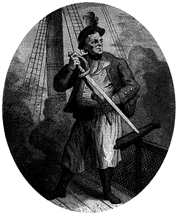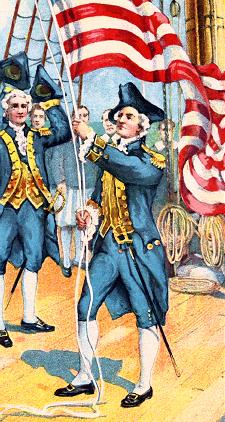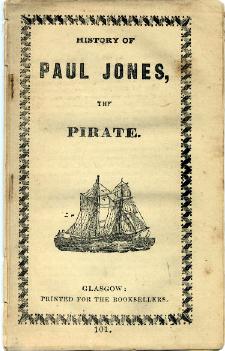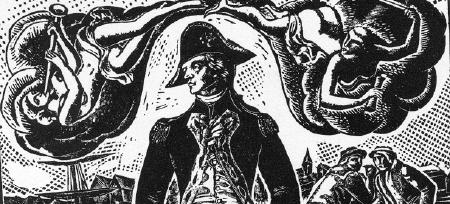|
FRESH STUFF DAILY |
|
|
||
|
|
||
|
|
||
|
SEE ALL SIGNED BOOKS by J. Dennis Robinson click here |
||
In Great Britain, where he raided his own native soil, he was considered a terrorist. In America, where he risked life and fortune in the American Revolution, he was a patriot -- although he was never a citizen and was later ignored.
July 6, 2007 marks the 260th anniversary of the birth of America's most famous, some say infamous, maritime figure since Christopher Columbus. If you want a bloody nose, just stand between two maritime historians as they debate the ethics and motives of John Paul Jones. A tireless promoter of his own deeds, he ultimately, though posthumously achieved the immortality he craved. Murder & Slavery
Soon after Jones was arrested for the alleged murder of a crewman who he ordered flogged. John Paul later produced eye witness testimony that the crewman died, not of his wounds, but of yellow fever while on another ship. Cleared of those charges, Jones quickly became embroiled in a second scandal when he ran his broadsword through a sailor who threatened his authority . According to a letter written years later to Ben Franklin, Jones was forced to defend himself against the ringleader of a mutinous crew while in the West Indies. It was, he wrote, the "greatest misfortune of my life". By his account, John Paul immediately rowed ashore to the island of Tobago to turn himself in to a justice of the peace. But he was advised by friends to leave behind his accumulated fortune and flee to America while waiting for a court hearing on the incident. Assuming the name John Jones, he arrived in the colonies in 1774 with the expressed intent of becoming a Virginia farmer after his name was cleared and his money reclaimed. Instead, he found himself in a new country on the brink of war and in desperate need of heroes. The opportunity to re-invent himself was clear. A Complicated Man Jones remains appealing as much for his actions as his personality. British chapbooks, an early form of dime novels, pictured him as a ruthless marauding pirate akin to Blackbeard. His attacks on British ships were often sudden and secretive, sometimes bloody. The vision of a swarthy scalawag persisted even to the writings of Rudyard Kipling a century later. In person, however, Jones was another man. Thomas Jefferson and others referred to him as "little Jones" and he may have been 5' 5". Unlike other merchant seaman, he was well dressed in a uniform of his design, carried a sword and conducted himself with practiced decorum. Add to that a thick Scottish braid accent and light Celtic features. He was never an easy man to get along with, intense about his honor and his duties, a harsh military master. But he was surprisingly sociable, a prolific poem and letter writer, spoke fluent French and, though he never married, was consumed by many romances. Above all, no one questioned his phenomenal maritime skills. To Britain, his use of that skill in covert military actions against the mother country certainly led to his presentation as a pirate. Wrapped In The Flag
By coincidence, Congress commissioned Jones Captain of the Ranger out of Portsmouth, NH on the very same day it approved design for the original Stars and Stripes -- June 14, 1777. The flag was described as "thirteen stripes, alternate red and white; that the union be thirteen stars, white in a blue field, representing a new constellation." It is likely that the Ranger's flag was not the circle of 13 stars so often pictured, but the layered arrangement of stars (3-2-3-2-3) that fell quickly out of fashion. For many, Jones became a true patriot when he convinced French flagship LaBretagne at Brest to return his 13 gun salute -- the first recorded acknowledgment of the new United States of America. Give Me Liberty -- Or Give Me Cash
Although he was generally disliked by the men who served with him, Jones exerted equal effort to obtain payments owed to his crew as well. He seemed also to respect the living conditions of his crew and prisoners, perhaps more than his contemporaries. If they disliked him, it was because he demanded from everyone, the same loyalty and over-the-top effort that he himself provided without question. While others fought for God, family and country, Jones apparently fought for Jones. Eventually he managed to serve the cause of freedom with the same professionalism that he applied to transporting cargo and slaves. In the end, he served under the command of the despotic Catherine the Great of Russia, a far cry from being champion of America. He died in 1792 without a fortune or fanfare.
Final Honors In 1905, after a costly search, his remarkably preserved body was discovered and removed from a grave site in Paris and transported to the USA. Through the intervention of President Theodore Roosevelt, Jones' remains were re-interred in an ornate tomb at the Naval Academy Chapel at Annapolis, Maryland. Today, despite his controversial past and personality, Jones is considered by many to tbe "Father of the American Navy." His name remains highly recognizable and his power to attract tourists to sites around the world is undiminished. © 1997 SeacoastNH.com. All rights reserved. Updated 2004 Photos: (Top) Jones depicted as pirate in 19th century, (next) engraving of Jones as pirate; (with flag) Jones raising the flag on Alfred from a 1905 insert to the Boston Globe; (booklet) cover of mid-19th century Scottish "penny dreadfu;"; and (bottom) Jones as patron saint of the US Navy. All images from SeacoastNH.com image collection and may not be used without written permission. Key Source: John Paul Jones: A Sailor's Biography by Samuel Eliot Morison, Faber and Faber, London, 1959. Please visit these SeacoastNH.com ad partners.
News about Portsmouth from Fosters.com |
| Wednesday, April 24, 2024 |


|
Copyright ® 1996-2020 SeacoastNH.com. All rights reserved. Privacy Statement
Site maintained by ad-cetera graphics

 The Shipyard
The Shipyard




 John Paul's early days, before he fled incognito to young America, contributed to the fearsome reputation that made him a legend. He did participate actively in the most repulsive occupation of his time, transporting slaves in ships totally unfit for humans. He soon quit what he called the "abominable trade" to make his fortune as a merchant captain.
John Paul's early days, before he fled incognito to young America, contributed to the fearsome reputation that made him a legend. He did participate actively in the most repulsive occupation of his time, transporting slaves in ships totally unfit for humans. He soon quit what he called the "abominable trade" to make his fortune as a merchant captain. From his first official day on the job as the earliest lieutenant in the new Continental Navy, Jones was symbolically bound to the USA. With his own hands, probably through his own request, he raised the Grand Union flag aboard his first commissioned ship The Alfred out of Philadelphia. Jones' biographer Samuel Eliot Morison underlines the point that this was not the thirteen star flag. Jones, he says, was showing his allegiance to the cause of liberty by raising an emblem that was half British, half American.
From his first official day on the job as the earliest lieutenant in the new Continental Navy, Jones was symbolically bound to the USA. With his own hands, probably through his own request, he raised the Grand Union flag aboard his first commissioned ship The Alfred out of Philadelphia. Jones' biographer Samuel Eliot Morison underlines the point that this was not the thirteen star flag. Jones, he says, was showing his allegiance to the cause of liberty by raising an emblem that was half British, half American. Jones always described himself as a loyal champion of American liberty, though he had a fondness for aristocratic ways. While he often took enemy merchant ships as prizes, he was technically not a privateer, though he was often described as one. Distribution of prizes taken by the military was carefully defined by Congress, as was the taking of American ships by the Royal Navy. Working for Congress was the least profitable occupation of all. The early navy survived on this salary-plus-percentage formula. Jones was simply better at his job than most, although collecting his due was difficult. He survived most of his tenure with the US Navy without income, even paying for supplies with his own money. Eventually Jones received a portion of his prize money. Because he did so and moved on, he is still seen by many as a highly efficient soldier of fortune. But in his time, when America's founding fathers were crafting a country while expanding their personal fortunes, Jones was not unique in this respect.
Jones always described himself as a loyal champion of American liberty, though he had a fondness for aristocratic ways. While he often took enemy merchant ships as prizes, he was technically not a privateer, though he was often described as one. Distribution of prizes taken by the military was carefully defined by Congress, as was the taking of American ships by the Royal Navy. Working for Congress was the least profitable occupation of all. The early navy survived on this salary-plus-percentage formula. Jones was simply better at his job than most, although collecting his due was difficult. He survived most of his tenure with the US Navy without income, even paying for supplies with his own money. Eventually Jones received a portion of his prize money. Because he did so and moved on, he is still seen by many as a highly efficient soldier of fortune. But in his time, when America's founding fathers were crafting a country while expanding their personal fortunes, Jones was not unique in this respect.















